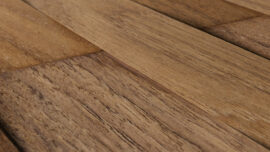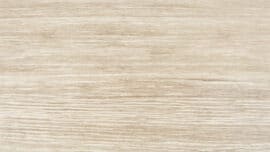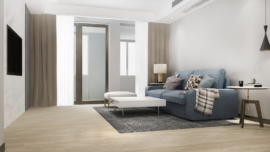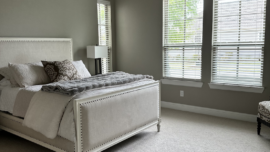
The Ultimate Guide to the Best Waterproof Flooring for Your Home
When considering home design and renovation, few decisions are as crucial as selecting the right flooring. Whether it’s for your kitchen, bathroom, or any other area prone to moisture, opting for a highly water-resistant floor is a smart move. With the evolution of flooring technology, homeowners now have a plethora of options to choose from, each offering durability, style, and, most importantly, water resistance. In this comprehensive guide, we’ll delve into the world of “waterproof flooring”, providing you with guidance to make the decision that is best for your home and your needs.
Expectations on “Waterproof” Flooring
Waterproof flooring is often touted as being able to withstand water without any issues. However, in reality, it’s more accurate to say that it’s highly water-resistant with some limitations. Claims of 100% waterproof flooring should be taken with a grain of salt because there’s always a chance of water seeping through, particularly around edges and seams. While waterproof flooring can certainly handle spills and moisture better than others, it’s important to recognize its boundaries and not expect it to defy the laws of physics.
1. Water-Resistant Laminate Flooring
Laminate flooring has come a long way in recent years, with manufacturers developing waterproof versions that rival the look and feel of hardwood. Water-resistant laminate flooring features a moisture-resistant core that prevents water damage, making it suitable for high-moisture areas like bathrooms and basements. With its affordability and easy installation, water-resistant laminate flooring is an attractive option for homeowners looking to upgrade their floors without breaking the bank.
2. Tile Flooring
Tile flooring has long been favored for its durability and water resistance, making it a natural choice for bathrooms and kitchens. Porcelain and ceramic tiles, in particular, are highly resistant to water and stains, making them easy to clean and maintain. With a wide range of colors, patterns, and textures available, tile flooring offers endless design possibilities for any space in your home.
3. Glue Down Vinyl Flooring
Glue-down vinyl flooring provides a durable and water-resistant solution for high-moisture areas like bathrooms and kitchens. Installed by adhering individual planks or tiles directly to the subfloor, this flooring offers strength, water resistance, and versatility in style. While requiring skill for installation, once in place, glue-do vinyl flooring requires minimal maintenance and offers long-lasting performance, making it a practical choice for any home.
4. Engineered Hardwood Flooring
While traditional hardwood flooring is not recommended for moisture-prone areas, engineered hardwood offers a viable alternative. Engineered hardwood consists of multiple layers of wood topped with a veneer of hardwood, providing the same luxurious look and feel as solid hardwood with added water resistance. While it may not be completely waterproof, engineered hardwood can withstand occasional spills and humidity levels, making it suitable for kitchens and living areas.
5. Waterproof Carpet Flooring
For homeowners who prefer the softness and warmth of carpet but require waterproofing, there are fully waterproof carpet options available. These carpets are treated with special waterproofing agents or feature waterproof backing to repel moisture and stains effectively. While not as common as other types of waterproof flooring, waterproof carpets can be a cozy addition to bedrooms, living rooms, and playrooms.
6. Waterproof Kitchen Flooring
The kitchen is often considered the heart of the home, making it essential to choose flooring that can withstand the rigors of daily life, including spills, stains, and moisture. When it comes to waterproof kitchen flooring, water-resistant laminate flooring stands out as a top contender.
Water-resistant laminate flooring offers the look of hardwood with the added benefit of water resistance, making it an ideal choice for kitchens. Brands like COREtec and Shaw Floorte have gained popularity for their innovative waterproof cores and realistic wood-look designs. Additionally, water-resistant laminate flooring is easy to clean and maintain, making it perfect for busy households.
7. Waterproof Flooring for the Bathroom
In the bathroom, where moisture levels are high and spills are common, choosing the right flooring is crucial. Traditional options like tile and stone offer water resistance but can be cold and hard underfoot. For a softer, more comfortable alternative, again, water-resistant laminate flooring
Water-resistant flooring, such as Mohawk SolidTech or Armstrong Pryzm, is designed to withstand the moisture and humidity present in bathrooms while providing warmth and comfort. These resilient floors come in a variety of styles, including tile and wood looks, allowing homeowners to create a cohesive design aesthetic throughout their homes.
Buying Guide
- Consider your specific needs: Assess the areas of your home where you need water-resistant floorings, such as bathrooms, kitchens, or basements, and consider the level of moisture and foot traffic in each space.
- Budget considerations: Determine your budget for flooring installation and explore options that offer the best value for your investment, considering factors like longevity, maintenance costs, and installation expenses.
- Research reputable brands and products: Look for well-known brands and products with positive reviews and certifications for water resistance and durability.
- Consult with flooring professionals: If you’re unsure about which waterproof flooring option is best for your home, consult with flooring professionals who can provide expert advice and recommendations based on your specific needs and budget.
- Consider installation and maintenance: Factor in installation requirements and maintenance procedures when choosing your waterproof flooring to ensure ease of installation and upkeep over time.
By following this buying guide and considering factors such as durability, design, budget, and maintenance, you can confidently select the best water-resistant flooring for your home, creating a stylish and functional space that withstands the test of time.
Conclusion
In the realm of home design and renovation, few decisions are as crucial as selecting the right flooring. Whether it’s for your kitchen, bathroom, or any other area prone to moisture, opting for highly water-resistant flooring is a smart move. With the evolution of flooring technology, homeowners now have many options to choose from, each offering durability, style, and, most importantly, water resistance. In this comprehensive guide, we’ve delved into the world of waterproof flooring, providing you with guidance to make the decision that is best for your home and your needs.
FAQs About Waterproof Flooring
Is waterproof flooring really waterproof?
No Flooring is 100% waterproof. Manufacturers for all types of flooring market their flooring as waterproof, but as professional installers and also a company who handles water mitigation and water restoration buildbacks on a regular basis, we know there isn’t a flooring that is waterproof because we pull up all types of flooring that has been a victim to a leak. If any flooring is waterproof, it would be carpet because it can be dried out. Most flooring types are now topically highly resistant to water, making it suitable for moisture-prone areas like kitchens and bathrooms. If you would like to know more and would like a professional to help you navigate through the flooring choices above, please inquire with us for more information.
How does waterproof vinyl flooring differ from traditional vinyl flooring?
Waterproof vinyl flooring has a water-resistant core, providing enhanced protection against water damage. It’s ideal for areas like bathrooms, kitchens, and laundry rooms.
Can waterproof flooring be installed over existing tile or hardwood floors?
In many cases, yes, but check manufacturer guidelines and ensure the subfloor is flat, clean, and structurally sound. Additional preparation may be needed.
How do I clean and maintain waterproof flooring?
Sweep or vacuum regularly, wipe up spills promptly, and use a mild detergent for deeper cleaning. Avoid harsh chemicals and steam mops, and follow manufacturer recommendations.







